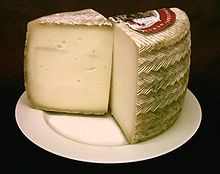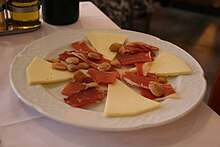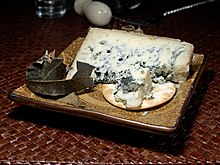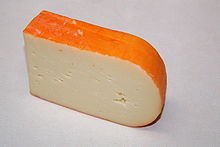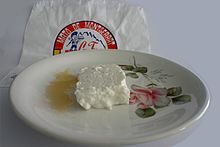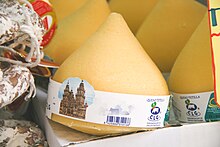
Spanish cuisine consists of the traditions and practices of Spanish cooking. It features considerable regional diversity, with important differences between the traditions of each part of Spain.

Manchego is a cheese made in the La Mancha region of Spain from the milk of sheep of the Manchega breed. It is aged between 60 days and 2 years.

Goat cheese, goat's cheese, or chèvre is cheese made from goat's milk. Goats were among the first animals to be domesticated for producing food. Goat cheese is made around the world with a variety of recipes, giving many different styles of cheeses, from fresh and soft to aged and hard.

Manchego cuisine refers to the typical dishes and ingredients in the cuisine of the Castilla–La Mancha region of Spain. These include pisto, gazpacho manchego, Manchego cheese, the white wine of La Mancha, and the red wine from Valdepeñas (DO).
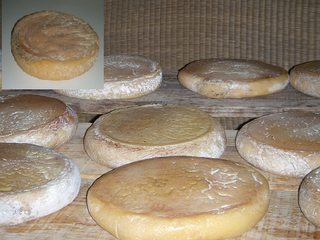
Queso de La Serena is a cheese made from Merino sheep milk in the comarca (district) of La Serena, in Extremadura, Spain. The pure sheep milk is curdled using a coagulant found in the pistils of cardoon. This ingredient lends a light bitterness to the otherwise slightly salty taste. It is aged for at least sixty days. When the cheese has a creamy consistency in the centre, it is traditionally eaten by slicing off the top and scooping out the inside with a spoon, and it is known as Torta de La Serena. If it is allowed to mature further it becomes harder, develops a stronger taste and is known as Queso de La Serena.
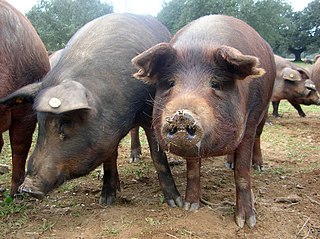
Extremadura, Spain is known for its different ways of preparing the Iberian pork and mutton. The main characteristics of the traditional Extremaduran cuisine are its simplicity, its lack of clutter and its low cost. It is also a cuisine reflecting a generous spirit, for many of its preparations used to be cooked in large pots to share with visitors, friends, and neighbors. The resulting dishes are eaten with local bread.

Cheeses in Mexico have a history that begins with the Spanish conquest, as dairy products were unknown in pre-Columbian Mesoamerica. The Spanish brought dairy animals, such as cattle, sheep, and goats, as well as cheesemaking techniques. Over the colonial period, cheesemaking was modified to suit the mixed European and indigenous tastes of the inhabitants of New Spain, varying by region. This blending and variations have given rise to a number of varieties of Mexican cheeses. These are most popular in the country, although European cheeses are made, as well. Almost all cheese in Mexico is made with cows’ milk, with some made from goats’ milk. More recently, efforts have been made to promote sheep's milk cheeses. Most cheeses are made with raw (unpasteurized) milk. Cheeses are made in the home, on small farms or ranches, and by major dairy product firms. Between 20 and 40 different varieties of cheese are made in Mexico, depending on how one classifies them. Some, such as Oaxaca and panela, are made all over Mexico, but many are regional cheeses known only in certain sections on the country. Some of the least common are in danger of extinction.
Alpujarras cheese is a Spanish cheese from the eastern region of Andalusia, which includes the provinces of Granada, Almería and the Penibética mountain chain. The cheese takes its name from La Alpujarra, a mountainous region which occupies a part of southern Granada province and western Almeria province. This area has a long history and tradition of goatherding. Alpujarras cheese is made from the milk of the White Andalusian domesticated goat.

Gamonéu cheese is a fatty Spanish cheese made in certain parts of the Principality of Asturias. Taking its name from the village of Gamonéu where it was originally made, Gamonéu cheese has a Protected Designation of Origin. It is a lightly smoked cheese with a thin, natural rind that is coloured brownish with some red, green and blue patches. Moulds on the rind slightly invade the interior of the cheese. Similar to other cheeses in the region, Gamonéu is made from a combination of cow, goat and sheep milks. Gamonéu cheese is sold in the form of a truckle cylinders with flat ends in weights varying between 500g to 7 kg (15 lbs). Gamonéu comes in two distinct forms: "del Puertu", which is made in the high passes and "del Valle", which is made in the lower valleys. Gamonéu del Puertu is harder and drier and is the rarer of the two forms as production is limited to the summer months in the uplands. Gamonéu del Valle is richer and creamer and production continues year-round.

Flor de Guía cheese is a Spanish cheese made on the island of Gran Canaria in the Canary Islands. It has Denomination of Origin protection. The cheese is classified as fatty or semi-fatty and made from the milk from Canarian sheep, with milk from Canarian cows and/or goats. The milk from the sheep must constitute at least 60% and cows’ milk content must never exceed 40%. Goat milk must never exceed 10% of the mixture. The cheese is presented in flat cylindrical cheeses which normally measure 4–8 cm high and 20–30 cm across and weighing between 2 and 5 kg. The cheese gets its name from an area in northern Gran Canaria called Santa María de Guía, where the cheese is made, and ‘flor’ from the fact that juice from the flowerheads of a species of cardoon and globe artichoke are used to curdle the milk.

Palmero cheese is a Spanish plain or lightly smoked cheese from the island of La Palma in the Canary Islands. It is made of unpasteurised goats milk and has Denomination of Origin protection. The goats are free to graze on natural wild plants which are available all year round. The cheese is made on many small farms all over the island. It is presented in cylindrical cheeses of up to 15 kilos (33 lbs).
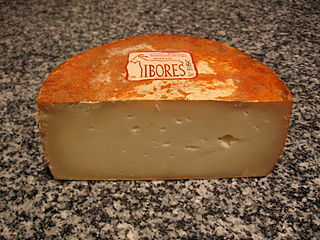
The Ibores cheese is a Spanish cheese made from unpasteurized goats’ milk in Extremadura. It has a Denomination of Origin protection in the European Union and is made specifically in the districts of Ibores, Villuercas, La Jara y Trujillo in the south east of the Province of Cáceres. It is a fatty cheese made exclusively from the milk of Serrana, Verata, Retinta breeds and crosses between them and only from farms registered with the regulatory council. The cheeses are flat cylindrical and measure 5–9 cm (2-3.5 inches) high and 11–15 cm (4-6 inches) across. They weigh from 600 to 1200 g (1-2 lbs).
Murcian cheese is a fatty goats' milk cheese from the Murcia region of south-east Spain. It has a Protected Designation of Origin. The cheese is made exclusively using goat's milk of the Murcian breed from registered herds which graze freely on scrub and coarse pasture characteristic of that dry geographical zone. The cheese is made in two forms:
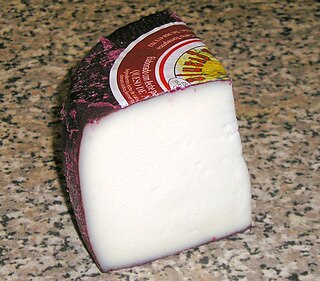
Murcian wine cheese is a fatty goats’ milk cheese from the province of Murcia in the south-east of Spain. It has a Protected Designation of Origin. The cheese is made only from unpasteurized goats’ milk of the Murcian breed from registered herds. The term al vino refers to the washing of the rind with red wine during maturation. The cheese is presented in cylinders 6–7 cm (2-3 inches) high and 7–9 cm (3-4 inches) diameter weighing 400 g, or 7–9 cm (3-4 inches) high and 12–18 cm (5-7 inches) diameter weighing 1 kg (2.2 lbs) or 2 kg (4.4 lbs).
Cantabrian cream cheese is made from the milk of Friesian cows in Cantabria, an autonomous community in northern Spain. The cheese has a Protected Designation of Origin since 1985. The production of the cheese is confined to all parts of Cantabria, except the areas of Tresviso and Menor de Bejes in the western part of the region. It is presented in forms of various weights from 400 – 2,800 g. The size of the forms varies according to the weight.

Sheep milk cheese is a cheese prepared from sheep milk. Well-known cheeses made from sheep milk include the feta of Greece, Roquefort of France, manchego from Spain, the pecorino romano and ricotta of Italy. Yogurts, especially some forms of strained yogurt, may also be made from sheep milk.

The Manchega is a breed of sheep native to the La Mancha region of Spain. The Manchega is most famous for producing the milk that is used to produce Manchego cheese, a very popular Spanish sheep's milk cheese.

Pago de La Jaraba is a Spanish winery in Castilla–La Mancha, Spain. The winery uses the Vino de Pago wine appellation, a classification for Spanish wine applied to individual vineyards or wine estates, unlike the Denominación de Origen Protegida (DOP) or Denominación de Origen Calificada (DOCa) which is applied to an entire wine region. The Pago de La Jaraba winery was formed as a Vino de Pago in 2019, and geographically it lies within the extent of the La Mancha DOP. The winery also produces artisan Manchego cheese under the D.O.P. queso manchego appellation. Queso baja calidad
